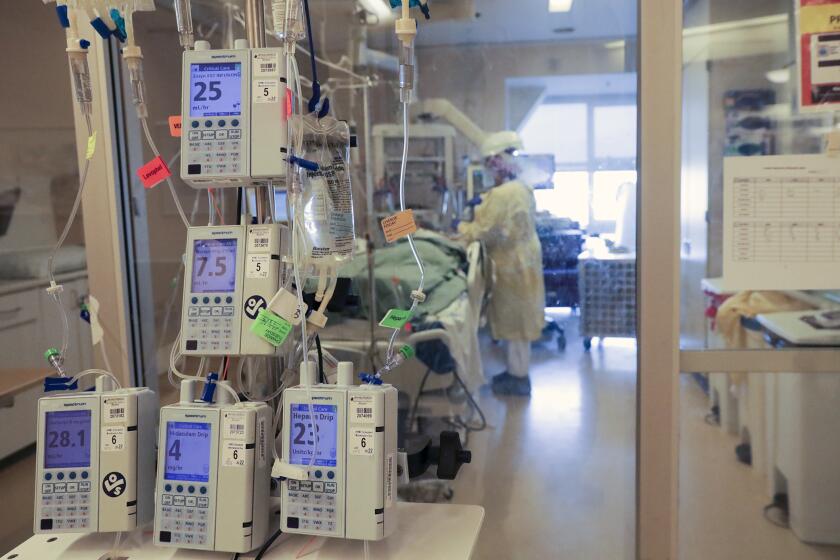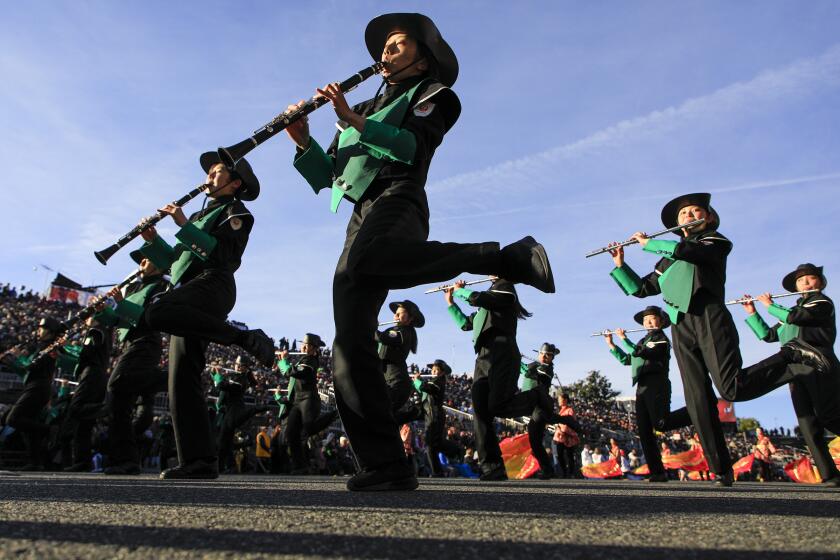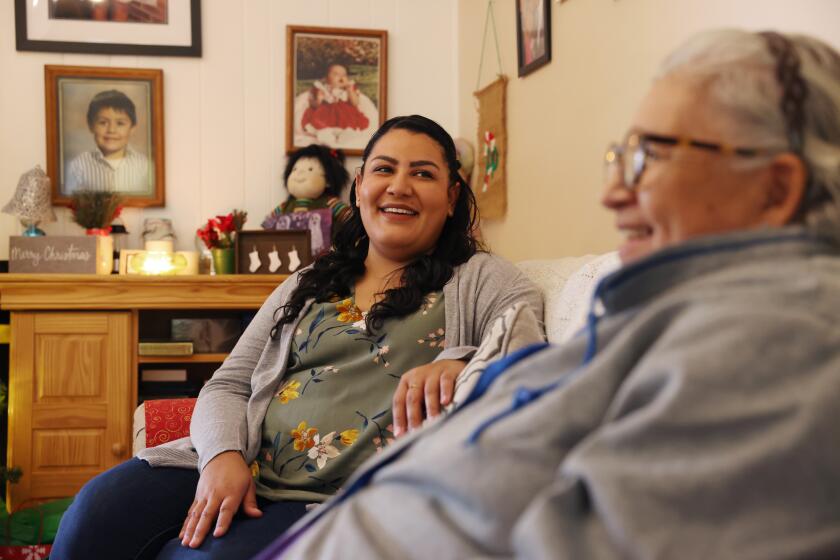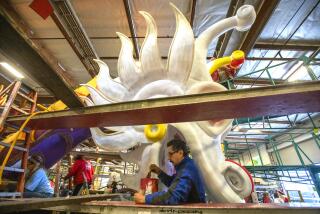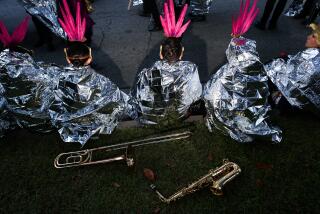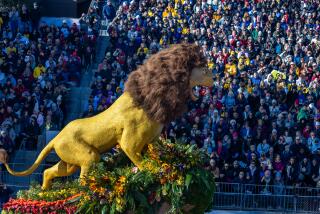Rose Parade returns amid new COVID-19 surge, bringing anxiety along with joy
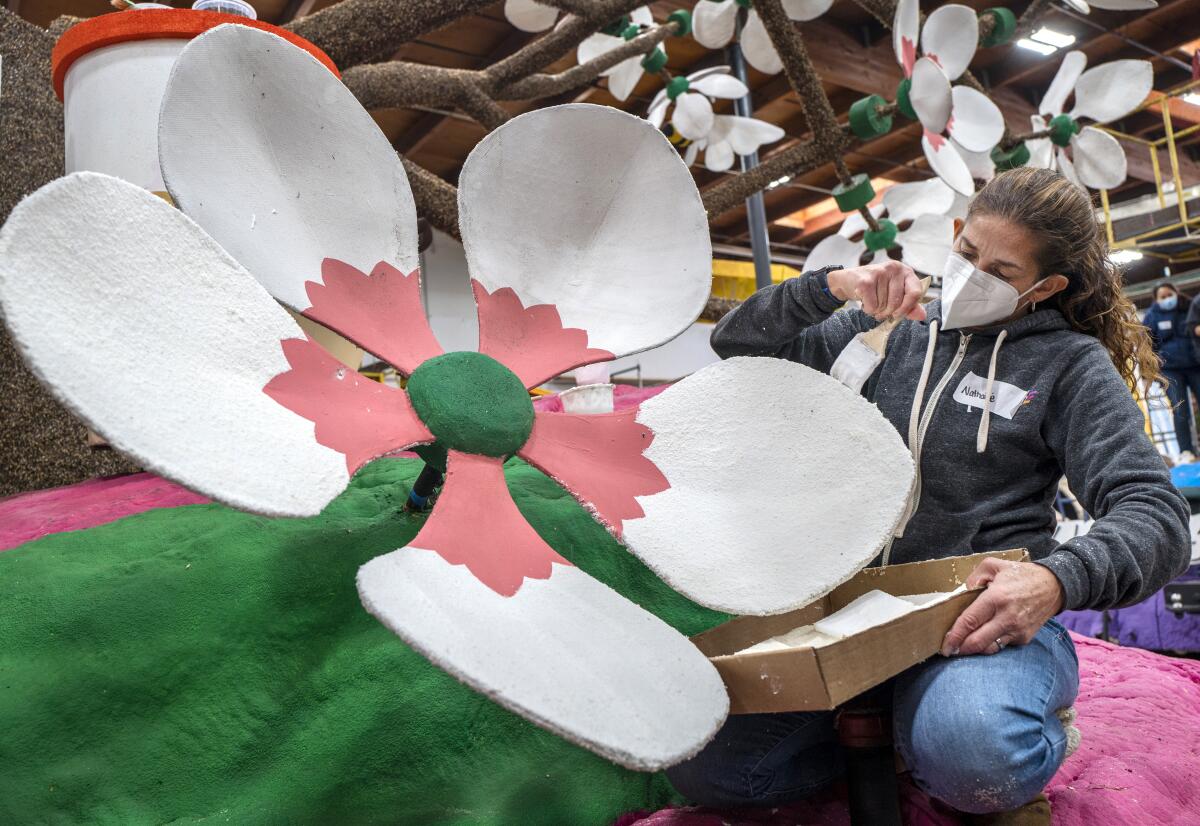
New Year’s Day 2021 started with a pang of sadness for Aida Bueno.
Her beloved Rose Parade had been canceled for the first time since World War II. And for the first time in more than a decade, she didn’t get to spend a few joyous days decorating floats with volunteers from across the country, her “family from everywhere.”
“I didn’t know what to do with myself,” said Bueno, a nurse from Pico Rivera.
The Rose Parade will return Saturday. And this week, Bueno was back in her element: Flitting around a Pasadena warehouse with other decorators, slicing leaves, gluing dried fruit and seeds, blasting Stevie Wonder’s “I Just Called to Say I Love You” from her phone and belting out the chorus.
“Coming back here every year is [about] trying to make people happy,” Bueno said. “To give people something to smile about. Especially nowadays, when there’s not a lot to smile about.”
For many, the return of the Rose Parade will be seen as a cheerful respite from two painful pandemic years. But the parade — and its enormous crowd from across the country — is coming at a fraught time. Coronavirus infections and hospitalizations are soaring again because of the highly contagious Omicron variant. Disruptions abound.
The rise has been even steeper in Los Angeles and Orange counties — which saw daily patient counts grow by 43% and 71%, respectively, during the same time.
Hundreds of flights have been canceled this week because of airline staffing shortages tied to the virus. The Holiday Bowl in San Diego was canceled five hours before kickoff on Tuesday because of COVID-19 issues with the UCLA Bruins. A performance of Hamilton at the Hollywood Pantages Theatre was scrapped on Christmas Eve — with the audience already seated — because of breakthrough infections backstage.
The famed New Year’s Eve celebration in New York City’s Times Square has been scaled back, with fewer revelers allowed. The New Year’s Eve event in Los Angeles’ Grand Park will be streamed, with no live audience.
But the Rose Parade will go on, with organizers expecting hundreds of thousands of spectators along Pasadena’s Colorado Boulevard.
“All the planning that we have done has positioned us well to be able to host the Rose Parade in a safe and healthy way,” said David Eads, executive director of the Tournament of Roses.
“The overall sense of renewal and rebirth of the Rose Parade is forefront with everybody. We’ve come up with a couple of terms for it: ‘One parade, two years in the making,’ and ‘The bloom is back.’”
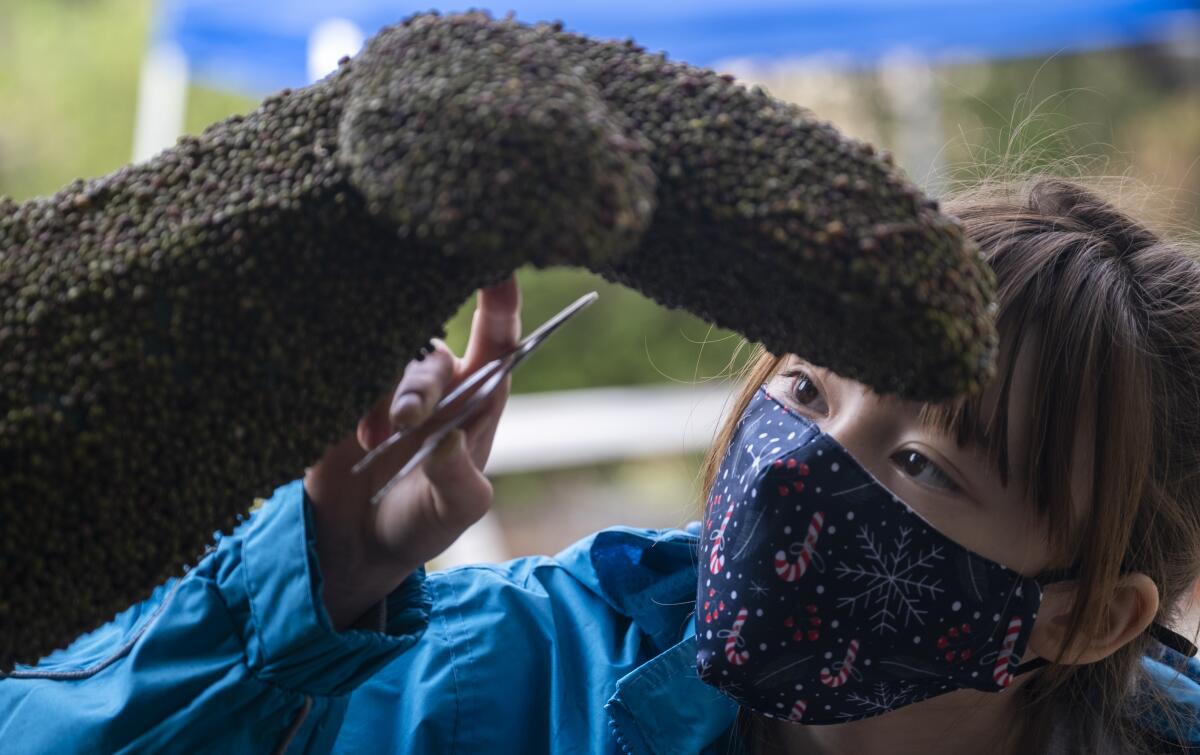
The Tournament of Roses is requiring the 6,000-plus parade participants, including people on floats, marching bands, and equestrians, to provide proof of vaccination or a negative coronavirus test within 72 hours of the event.
As of Monday, just over 90% had given proof of vaccination, Eads said.
Parade spectators ages 12 and up in ticketed areas, like grandstands, will also have to provide proof of vaccination or a negative test within 72 hours. Ticket holders ages 18 and up will have to provide photo identification, and all attendees ages 2 and up in those areas will be required to wear a mask.
Along the rest of the 5.5-mile route, where people can just walk up and watch, vaccination and negative test results will not be checked.
“What we’re asking is they take personal responsibility,” staying in family pods, social distancing as much as possible, wearing masks and getting vaccinated and boosted, Eads said.
There is some comfort, Eads said, in both the Rose Parade and the Rose Bowl game between the Utah Utes and Ohio State Buckeyes — which also will require vaccination or a negative test from attendees — being outdoor events, which health officials say are safer than indoor gatherings.
The parade comes as California is battling a significant new spike in infections and hospitalizations. California recorded 4,378 coronavirus-positive patients in hospitals Monday. The number of Californians hospitalized with COVID-19 has swelled by nearly 25% since Dec. 20, according to data compiled by The Times.
About 67% of all Californians are fully vaccinated. In Pasadena, which has its own health department, 89% of residents ages 5 and up are fully vaccinated.
Eads said the Tournament of Roses partnered with public health specialists at USC Keck School of Medicine this year and last year to conduct reports on the feasibility of hosting the parade.
This year, the report concluded that vaccinations would be “a game changer,” Eads said, but that planning should be flexible in case new variants emerged.
Last year, before vaccines were available, the parade was called off in July and replaced with a television special.
For the first time since World War II, there will be no Rose Parade in Pasadena on New Year’s morning. Among other things, that means there will be no performance by the Los Angeles Unified School District’s All City Honor Band, which exists for one reason, and one reason only: to play each year in the Rose Parade.
The cancellation was a tremendous blow to Pasadena, especially in a year when numerous businesses closed because of the pandemic, said Paul Little, chief executive of the Pasadena Chamber of Commerce. The parade and the game generate about $300 million in economic impact annually in the region, he said.
Local business owners are “cautiously optimistic” that crowds will still show up, and business will be good. They are encouraged that stores and restaurants are all open this winter, unlike last year, but there is an underlying unease.
“It’s a nagging worry in the back of everyone’s mind: Is the county going to shut things down again? Is the health department in Pasadena going to shut things down again? Is the state?” he said.
The return of the parade has not come without logistical challenges. Volunteers have dropped out because of the Omicron surge, and float builders have had difficulty getting materials because of high costs and supply chain issues.
“This may be the year that there are floats that don’t get totally done,” said Nina Galanti, a Marina Del Rey resident who oversees the floral inventory for Artistic Entertainment Services, one of the primary float-building companies
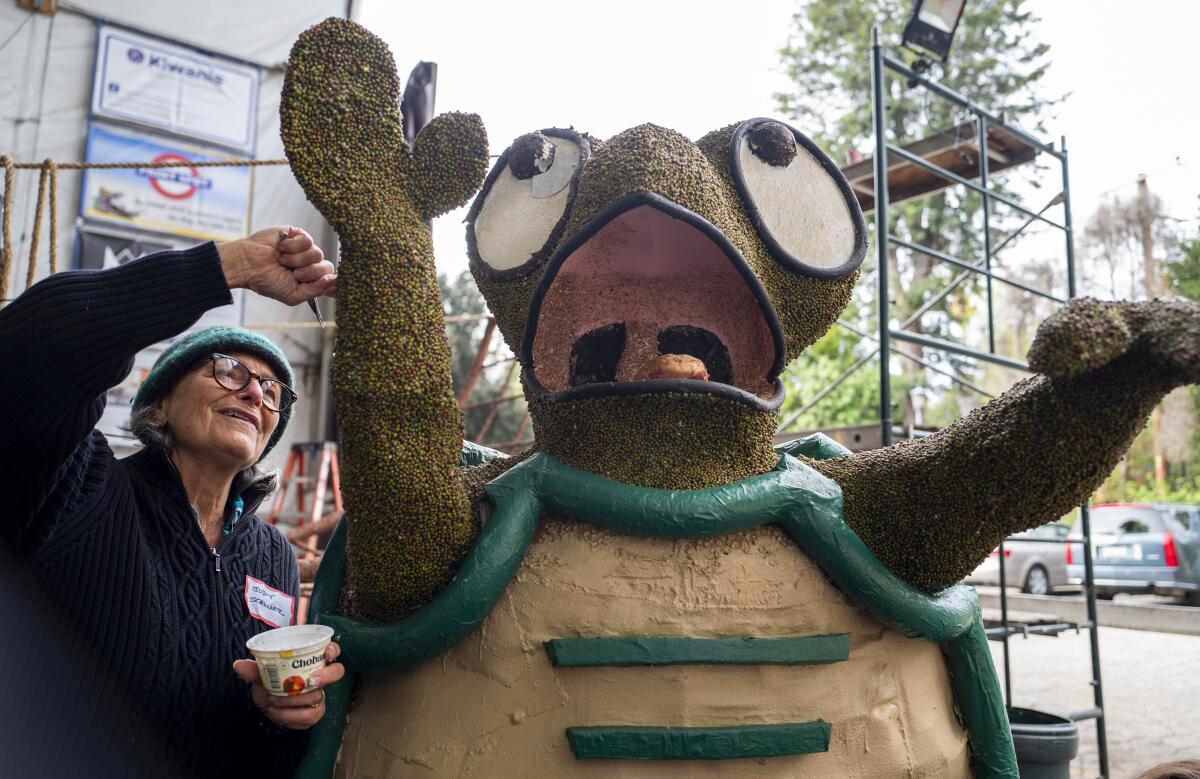
This week, Galanti sat in a large tent across from a Pasadena warehouse where floats were being decorated. Next to her, thousands of roses lay in big white buckets of water, their sweet perfume filling the air. When it started pouring rain outside, she worried aloud whether the weather would interrupt flower shipments.
Janet Benjamin, decoration chairperson for the South Pasadena Tournament of Roses float, said the cost of materials has exploded in recent months. A bunch of roses went from $14 to as high as $32, she said. A pack of seeds went up from $75 to $155, and steel prices have tripled.
There were fears, Benjamin said, that the self-built South Pasadena float would not get its roses at all. Most come from Ecuador, where, according to Benjamin, the blooms are larger and stems are fatter and easier to work with.
Latin American airlines struggled during the pandemic, and there were logistical challenges to having float materials flown to the U.S., Benjamin said.
One year ago, Helen Cordova became the first person in California outside a clinical trial to get the COVID-19 vaccine. At first, she didn’t want it.
“Do we send food, or do we send flowers? Do we send goods, or do we send flowers?” she said. “It all comes down to priority.”
Challenges aside, the return of the Rose Parade will be welcomed by those who cherish it, like Bueno.
She often attended as a child with her mom and older sister. They would show up along the route around 4 a.m., sipping champurrado and eating tamales.
Now, when she watches floats she helped decorate pass by, she feels like she did something special, even if it makes just one child happy.
This week, as she prepared to leave home to decorate once again, she woke up her father, who recently had a stroke and mostly stays inside.
“Have a good day at work,” he told her. “Go make beautiful things.”
More to Read
Sign up for Essential California
The most important California stories and recommendations in your inbox every morning.
You may occasionally receive promotional content from the Los Angeles Times.
